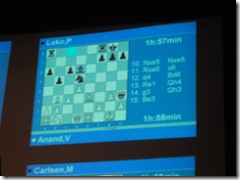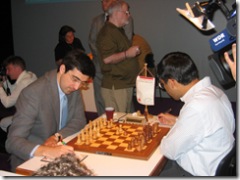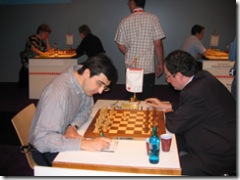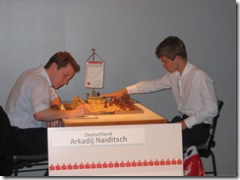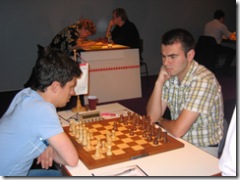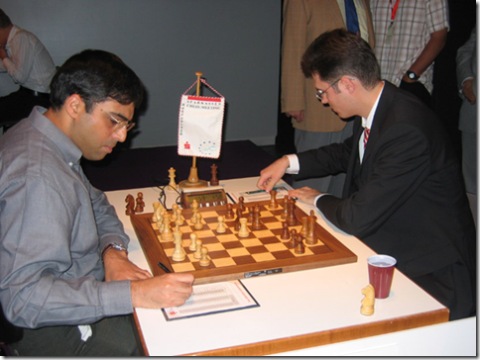The Marshall of Dortmund
Last weekend I visited Dortmund to see some top level chess.
In Dortmund they present the chess tournament in a theater (above, left). The chess boards are visualized to the spectators with a huge display above the stage (above, right). The moves are also automatically transmitted from the electronic boards to the Internet. This year the Internet transmission has a 15-minutes delay (the idea is that this should prevent cheating with a computer, but I doubt both that any cheating happens at the top level, and that this measure would be effective).
The first round saw the clash between the current world champion and the world number one. Vishy is now using the Slav regurlarly and achieved a draw with Black. In the second round Kramnik scored his first win - no presents for Gelfand on his birthday.
The tournament combines four players that will play in the world championship tournament later this year in Mexico (Kramnik, Anand, Gelfand, and Leko) with one player from Germany (Naiditsch), and three young players (Carlsen, Alexeev, and Mamedyarov). Carlsen already has regular invitations to top events this year. Alexeev won the Russian championship and qualified via the Aeroflot open. Mamedyarov has established himself in the top ten.
I was very glad to see a real Marshall at top level, as I am getting a bit bored by the Mostly Harmless Anti Marshalls. So I was excited to be able to stand next to the game when they played the opening moves and take a photo of it.
I am not so sure about the move order they played in the game. Leko played the Adams-Variation move order with 17..Qh5, when 18.a4 Bf5 would lead into the Adams variation, or 18.a4 Re6 would transpose to the Spassky variation, which is the main line these days. Vishy played 18.Qf1 (see diagram on the left).
This allows Black to play 18..Bh3 and if White wants to avoid a repetition he would have to go into the Adams variation with 19.Bd1 Qf5 20.Qe2 a tempo down (he has not played a4).
However Peter played the game in Kramnik's I-am-the-wall (TM) style, accepting a slightly inferior endgame where White cannot win. In fact the position in the end (see diagram on the right) is still given as superior for White by all the silicon chess players, as White is a pawn up. But if you play out the position you realize that White cannot easily make any progress. Black's bishop pair seems to deny White the chances to activate his pieces or push his pawn.
Being confident with this plan, Peter didn't bother about Adams or Spassky variation, and introduced the move 18..Re7.
During the game I thought that after 19.a4 Rfe8 20.Bxd5 Qxd5 22.axb5 axb5 (see diagram) White should use the fact that there is no rook on the sixth rank by playing 22.Qg2 - if Black's queen moves away White can take on c6 and does not have to fear moves like Bxg3. After seeing the game I think that Black would just exchange queens after 22.Qg2 and try a similar endgame.
Can White find some ways to play this or is the Marshall just a draw? Food for thought.

